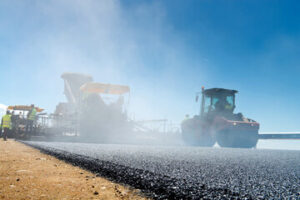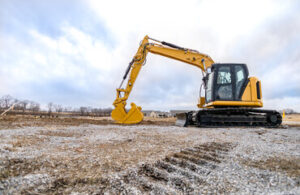Asphalt is a dark, durable material that stands up to traffic and weather. Its low maintenance costs and resilience make it a popular choice for parking lots, roads, and other infrastructure projects.

Quality asphalt is environmentally friendly, incorporating recycled materials and energy-efficient production processes. It also offers a wide variety of design options to suit your property’s architectural style. Contact Asphalt Paving Charleston SC for professional help.
Hot mix asphalt is the most common type of asphalt used in major paving projects. It is made by heating aggregates and asphalt cement at a plant and then transporting it to the construction site to be placed and compacted.
It is highly durable and can withstand heavy traffic loads, extreme weather conditions, temperature changes and the regular expansion and contraction that comes with driving over a road’s surface. This resilience extends the life of a road, cutting down on maintenance costs.
HMA comes in several subtypes, with each offering specific benefits suited to a particular project’s needs. For example, dense-graded mixes are known for their balance of durability and application ease and are a good choice for high-traffic areas. Gap-graded mixes, on the other hand, are a good choice for rainy climates and have the added benefit of managing stormwater by draining water into the ground.
The right mix type can make all the difference in a paving project. It’s important to consider an area’s weather conditions, expected traffic volume and available equipment when choosing a mix. By doing so, you can ensure that your resulting pavement will be well-suited for its environment and will last longer than a non-optimal mix.
In order to guarantee proper compaction and structural integrity, all HMA mixtures must meet certain specifications. This includes achieving a target laboratory-molded density and maintaining an asphalt binder content within a range that minimizes aging and permeability.
When designing an HMA mixture, the design engineer must also take into account how the mix will be placed and compacted on the construction site. This involves determining an appropriate ratio of course and fine aggregates, as well as the optimum amount of asphalt cement to support these requirements.
HMA can be modified to improve workability by adding additives that reduce its viscosity and help it adhere to the aggregate particles, even at lower temperatures. This allows for easier manipulation and a higher degree of compactive effort. In addition, these additives can also help to mitigate issues with stripping and water damage. This is particularly important because the sensitivity of asphalt to moisture damage can increase with increased traffic load or temperature extremes.
Cold Mix
Conventional cold mix asphalt is a viable choice for many road repair and maintenance applications. It is a great choice for patching potholes or other distressed areas of existing pavement and can extend the life of the existing surface until a long-term treatment can be installed. Cold mix is composed of DOT compliant coarse and fine aggregates blended with specially designed High-Float emulsions. This creates a mixture that has both early initial strength and high flexibility for long-term performance.
Cold mix can be used to fill minor depressions, potholes and other low-traffic surfaces, especially when the conditions are too warm for hot mix asphalt. It is made from a combination of aggregates and liquid bitumen, typically using two types of cut back bitumen (MC 3000 or SC 6000). The cold mix is then combined with a hot or cold binder in a central plant mixing system through a pugmill. The resulting emulsified mixture is then loaded into trucks and hauled to the job site where it can be placed using conventional self-propelled pavers or towed spreaders.
Another alternative to traditional cold mix asphalt is Warm Mix Asphalt (WMA). This process uses a lower production temperature which reduces fumes and air quality on the jobsite and at the plant. It also keeps the asphalt mix workable longer so it can be installed during cooler temperatures and extends the paving season.
WMA is a sustainable material that utilizes recycled asphalt pavement (RAP). RAP is a significant portion of the mix and saves money, cuts landfill waste, and supports green construction goals. It is important to note that while WMA offers the same paving benefits as other asphalt mixes, it has a different installation process and requires more monitoring on the jobsite.
Porous asphalt is a highly durable mix that provides the same structural benefits as HMA while promoting environmental sustainability and reducing costs. This is achieved by creating open space in the final product, which allows water to pass through and drain below the surface. This helps reduce standing water, minimize runoff and filter pollutants into the soil. In addition, the voids in porous asphalt help protect the subbase from moisture and freezing temperatures.
Porous Asphalt
Porous asphalt is a variation of standard bituminous asphalt where the fines are screened and reduced to create small void spaces that allow water to pass through. This allows the pavement to serve a dual function, providing a durable surface for vehicles and pedestrians while also treating stormwater runoff as it does on natural soils. This type of pavement can be used on parking lots, walkways and low traffic streets. It is a very durable surface that can handle the same loads as a standard asphalt lot.
During a rainfall, water drains through the porous asphalt layer and into an underlying stone bed where it slowly infiltrates back into the ground as nature intended. This infiltration process cleanses the stormwater, replenishes aquifers and reduces pollutants. Because the paving system is permeable, it eliminates the need for an expensive detention basin and saves money on construction costs.
In addition to reducing the volume of stormwater runoff, porous asphalt also provides thermal energy in the form of re-heated snow and rain. This helps to melt ice and snow, and can help to prevent re-freezing of the surface. The open-graded material also helps to cool the asphalt surface in summertime, and is a safer alternative to other pavement materials for pedestrians.
The design of a porous asphalt pavement with an underlying stone reservoir requires special consideration. To maximize the benefits of a porous asphalt pavement, it must be designed to provide a minimum of 40% void space. The stone reservoir should be placed over a well-compacted subgrade, not on recent fill or compacted fill, as these materials may not provide adequate infiltration capacity. The designer should also review National Asphalt Pavement Association (NAPA) Information Series 131 to ensure that the paving system will meet stormwater performance criteria, including the ability to retain a 2-year, 24-hour storm event and provide a water quality volume of at least 20%.
Porous asphalt requires less maintenance than traditional asphalt and is a great choice for low-traffic areas such as sidewalks, courtyards and plazas. The porous surface is more forgiving to the effects of freeze-thaw cycles, and will remain functional for many years before showing signs of wear and tear.
Asphalt Repair
Asphalt is a budget-friendly paving option, and it typically takes less time to install than concrete. This means you can have your parking lot or driveway open and ready for traffic sooner. It is also a durable material that can support the weight of vehicles for many years, without cracking or deteriorating. Regular maintenance, like seal coating and crack filling, helps extend the lifespan of your asphalt pavement.
Like any paved surface, asphalt requires site preparation, ground compaction, and an appropriate base material to ensure long-lasting performance. After this, the asphalt mix is laid and compacted on-site using rollers to eliminate air pockets and achieve a level, smooth surface. The final product is inspected for quality and compliance with industry standards.
The primary ingredient of asphalt is bitumen, a dark viscous material that holds the aggregate together. It is a petroleum byproduct and therefore vulnerable to price fluctuations, which can affect the overall cost of the project. Asphalt paving is often used to build roads and highways, due to its durability and ability to withstand high volumes of traffic.
An asphalt construction project begins with proper site preparation, including removing existing vegetation and clearing the area. A base layer of crushed stone or gravel is then laid on the ground and compacted. The contractor then layers the asphalt mixture, using an asphalt paver to create a smooth, even surface that is both thick and durable. Once the asphalt is laid, it is compacted again by rolling machines, and inspected to meet quality requirements.
After the paving process, it is important to keep traffic off the new surface while it cools and cures. This is usually done with barriers and signage, and it will help prevent premature wear and tear. It is also recommended that you have your pavement tack coated with a layer of asphalt emulsion, which will make it more resistant to water damage.
Asphalt is a versatile, affordable material that offers many benefits for residential and commercial property owners. However, it is not indestructible, and regular maintenance is necessary to extend its life span. Regular inspections for cracks and other damages should be conducted, and repairs should be made as soon as possible to prevent the cracks from expanding into potholes or larger areas of crumbling pavement.




